Partial sales, SCC in new avatar and other crucial IBC amendments (Presentation)
 Loading…
Loading…
Deliberation by Mr. Vinod Kothari and Ms. Sikha Bansal in the session organized by ICSI-IIP on the topic can be viewed here
 Loading…
Loading…
Deliberation by Mr. Vinod Kothari and Ms. Sikha Bansal in the session organized by ICSI-IIP on the topic can be viewed here
– Sameer Gahlot | Assistant Manager | finserv@vinodkothari.com
The Insolvency and Bankruptcy Code, 2016 (‘Code’/ ‘IBC’) provides for a collective resolution mechanism – claims of multiple creditors of different nature are collated by the resolution professional or liquidator, as the case may be, which are then repaid from the recoveries made, either pursuant to a resolution plan or by way of realisation under the liquidation process. Thus, in either case, to be able to recover their dues from the corporate debtor, it is pivotal that such party qualifies as a ‘creditor’ with a legitimate ‘claim’ as per the Code.
That being said, while crystallized claims can be easily accounted for, the problem lies where claims are either contingent or unascertainable. Though there have been various judicial developments in this domain, the laws are still not settled and uncertainty looms over the following questions:
SEBI’s (Third Amendment) Regulations go live!
Anushka Vohra | Manager | corplaw@vinodkothari.com
On August 03, 2021, SEBI (Listing Obligations and Disclosure Requirements) (Third Amendment) Regulations, 2021[1] (Third Amendment Regulations) were notified to become effective from January 01, 2022. The amendment brings changes in the regulatory framework for Independent Directors (IDs) including but not limited to criteria of independence, appointment framework, composition of IDs in committees of the board, etc. The amendment is a move towards protecting the interests of a larger set of shareholders.
In this write-up we will be discussing the revised appointment and re-appointment framework for the IDs.
As per the provisions of law and given the standard practice, the appointment of IDs is done as follows:
The current practice of re-appointment of IDs is as follows:
SEBI Consultation Paper[2]
On March 01, 2021, SEBI came up with a Consultation Paper (‘Paper’) for reviewing the regulatory provisions relating to IDs viz. their independence, appointment, re-appointment and remuneration.
The Paper proposed two significant changes in the process of appointment, re-appointment and removal of IDs i.e. ‘dual approval’ and ‘prior approval’. The relevant extract is quoted herein below:
‘Appointment and re-appointment of IDs shall be subject to “dual approval”, taken through a single voting process and meeting following two thresholds: –
The approval at point (i) above, shall be through ordinary resolution in case of appointment and special resolution in case of re-appointment.’
Further, concerns were raised on the current framework for appointment of IDs, as discussed above. The Paper expressed that the significant gap between the appointment of an ID and approval of shareholders is not in the best interest of the shareholders, especially the minority shareholders. Accordingly, the Paper proposed to take prior approval of shareholders for appointment of IDs. The relevant extract is quoted herein below:
‘Independent Directors shall be appointed on the board only with prior approval of the shareholders at a general meeting.
In case, a casual vacancy arises due to resignation / removal / death / failure to get re-appointed etc., the approval of shareholders should be taken within a time period of 3 months.’
SEBI Board Meeting[3]
Post the receipt of the comments on the Paper, SEBI at its board meeting held on June 29, 2021 reviewed the regulatory provisions related to IDs. It is significant to note that the proposal of ‘dual approval’ and ‘prior approval’ was not approved by SEBI considering difficulties it could impose during implementation including delay in appointment of IDs in case of a deadlock, etc. Thus, SEBI took a balanced view and introduced a process which is simpler to implement and covers a greater set of shareholders. SEBI, therefore, decided that appointment, re-appointment and removal of IDs shall be through a special resolution of shareholders for all listed entities, applicable from January 01, 2022.
Therefore, it is absolutely clear that the proposal for obtaining prior approval of shareholders was dropped by SEBI.
Amended provisions
The Amended Regulations inserted sub-regulation (1C) to Regulation 17 and sub-regulation (2A) to Regulation 25 which requires passing of a special resolution for appointment, re-appointment as well as removal of IDs. Further, another pertinent change brought about by the amendment is that the approval of shareholders is required to be passed within a maximum of 3 months from the date of appointment by the board.
Hence, on a conjoint reading of both Regulations 17(1C) and 25(2A), the following is understood:
Regulation 25(2A) states that the appointment of an independent director shall be subject to the approval of shareholders. Whether the approval required is prior or post-facto has not been specified. However, on understanding the background of the amendment in the Regulation, and by harmonious construction of this Regulation with Regulation 17 (1C) it is clear that the approval may be post-facto. The approval referred to in Reg 25 (2A) does not necessarily mean prior approval. It is a stated law that approval includes post- facto approval too.
In Black’s Law Dictionary (Fifth Edition)[4], the word “approval” has been defined as follows:
Approval. – The act of confirming, ratifying, assenting, sanctioning, or consenting to some act or thing done by another.
Hence, approval to an act or decision can also be subsequent to the act or decision.
Also, in the case of Vijay S. Sathaye v. Indian Airlines Ltd & Ors[5], the Hon’ble Supreme Court held that, ‘Approval means confirming, ratifying, assenting, sanctioning or consenting to some act or thing done by another.’Further in the case of Union of India v. Sunny Abraham[6], the Delhi High Court held that, ‘the dictionary meaning of the word “approval” includes ratifying of the action, ratification obviously can be given ex post facto approval.’ The Court also pointed out in this case that if the provision of law requires prior approval, it will specifically prefix the approval by “prior”.
The Allahabad High Court in Shakir Hussain v. Chandoo Lal[7] held that, ‘Of course the expression “subject to approval by the Court” implies that the arrangements which are considered by him to be most convenient and economical must be made by him first and approved by the Court subsequently. It is not necessary for him to submit his proposal beforehand and get approval though such a course is not impossible.’
Hence, we are of the view that provision of Reg 25 (2A) does not deviate from the provisions of Reg 17(1C) giving a time of 3 months or by the calling of the ensuing AGM, whichever is earlier, for shareholder’s affirmation of the appointment of an independent director.
Hence, with effect from 1st Jan., 2022,, the process for appointment of an ID stands as follows:
Concluding remarks
The requirement of special resolution would safeguard and protect the interest of shareholders and the independence of the IDs. Covering a greater set of shareholders would ensure that the composition of ID is not influenced by the whims of the majority shareholders. Hence, this move would increase the participation of shareholders in approving the appointment of a person, whom they want to be represented on the board of directors.
[1] https://egazette.nic.in/WriteReadData/2021/228705.pdf
[2] https://www.sebi.gov.in/reports-and-statistics/reports/mar-2021/consultation-paper-on-review-of-regulatory-provisions-related-to-independent-directors_49336.html
[3] https://www.sebi.gov.in/media/press-releases/jun-2021/sebi-board-meeting_50771.html
[4] https://www.latestlaws.com/wp-content/uploads/2015/04/Blacks-Law-Dictionery.pdf#page=208
[5] https://indiankanoon.org/doc/86328176/
[6] https://indiankanoon.org/doc/152013330/
[7] https://indiankanoon.org/doc/1531761/
[8] Though the Listing Regulations already require the NRC to formulate criteria regarding such appointments, the role of NRC, in practice, does not suffice the intent of law properly. Therefore, vide the Amendment Regulations, SEBI has brought amendment to Para A of Part D of Schedule II of the Listing Regulations thereby specifying the procedure for selection of candidates for the role of NRC. The procedure is in line with the proposal laid down in the Paper.
[9] https://vinodkothari.com/2021/03/revised-regulatory-framework-for-ids/
On September 24, 2021, the RBI released Master Direction – Reserve Bank of India Securitisation of Standard Assets) Directions, 2021. The same has been released after almost 15 months of the comment period on the draft framework issued on June 08, 2020. This culminates the process that started with Dr. Harsh Vardhan committee report in 2019.
It is said that capital markets are fast changing, and regulations aim to capture a dynamic market which quite often leads the regulation than follow it. However, the just-repealed Guidelines continued to shape and support the securitisation market in the country for a good 15 years, with the 2012 supplements mainly incorporating the response to the Global Financial Crisis. Read more →
Managerial-Remuneration_Burhanuddin
Other ‘I am the best’ presentations can be viewed here
SLBs awe-inspiring issuers and investors ! Payal Agarwal, Executive (payal@vinodkothari.com) ESG or Environmental, Social and Governance concerns are been on a high focus in recent times. The issues are not only been addressed by the environmentalists, but the corporate world is also becoming more and more attentive towards the ESG concerns and devising various ways and means to collate them with their operational activities. One of the various such treads in this regard is the issuance of ESG focussed bonds, which is gradually becoming a popular trend in the global economy, India being no exception. These bonds give a boost to sustainable finance, helping issuers raise finance and investors ensuring their investments fulfil their sustainability goals.
In India, the green bonds[1] are one of the most popular and legally recognised means of raising sustainable finance. SEBI, vide its circular dated May 30, 2017 has issued “Disclosure Requirements for Issuance and Listing of Green Debt Securities” which are in addition to the general requirements under the SEBI (Issue and Listing of Debt Securities) Regulations, 2008. Amidst the constant push towards business sustainability and responsibility conduct through reporting for listed entities[2], India also recognised the need for such ESG debt securities in the Consultation Paper released on draft International Financial Service Centres Authority (Issuance and Listing of Securities) Regulations. The said consultation paper provides for a framework for issuance and listing of securities, including ESG debt securities in the stock exchanges under the IFSC region in India. Now, the International Financial Service Centres Authority (Issuance and Listing of Securities) Regulations, 2021 (“IFSC Regulations”) provide a framework for listing of “ESG debt securities”. In this article, we will discuss the internationally recognised means of raising sustainable finance and the present and potential capacities of India in raising such sustainable finance by means of ESG debt securities.
As the name suggests, ESG bonds or debt securities are debt instruments that are linked to or contribute to the development of ESG concepts in some way or the other. The International Capital Market Association (ICMA) recognises 4 types of bonds that are interested in sustainable financing –  Further separate guidelines[3] have been issued by ICMA in respect of each of these bonds. A snapshot showing comparative between these 4 types of bonds is as follows –
Further separate guidelines[3] have been issued by ICMA in respect of each of these bonds. A snapshot showing comparative between these 4 types of bonds is as follows – 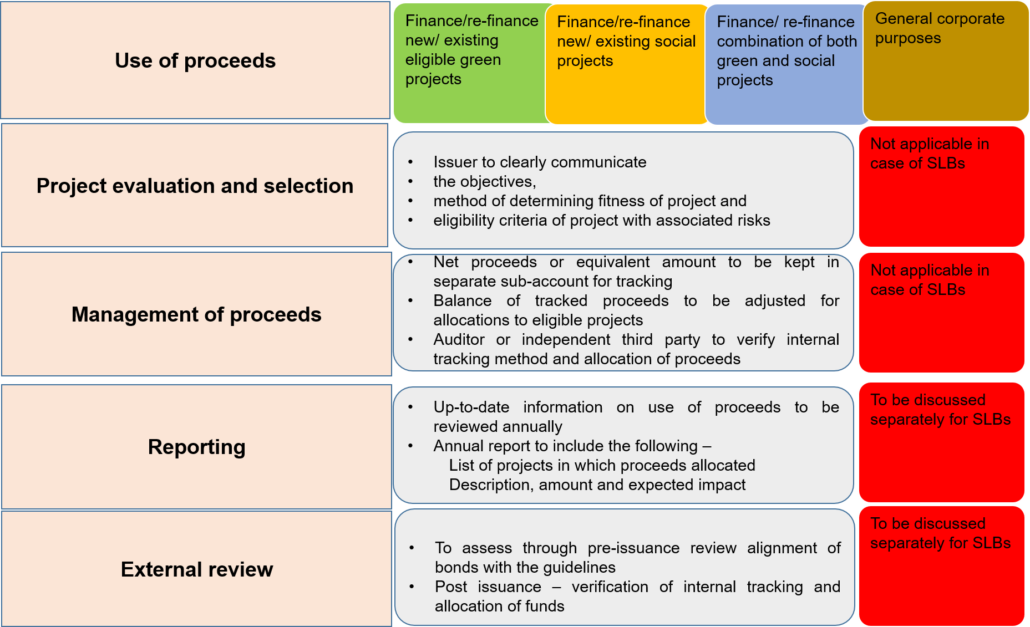 A study of these guidelines show that the SLBs are quite different from other sources of sustainable finance, being “general corporate funds” instead of “use of proceeds” funds. Therefore, the same has been discussed separately in later parts of this article. Further, the categories of projects in which proceeds of green bonds, social bonds, and sustainable bonds can be used have been listed below (the list is illustrative) –
A study of these guidelines show that the SLBs are quite different from other sources of sustainable finance, being “general corporate funds” instead of “use of proceeds” funds. Therefore, the same has been discussed separately in later parts of this article. Further, the categories of projects in which proceeds of green bonds, social bonds, and sustainable bonds can be used have been listed below (the list is illustrative) – 
 Similar standards have been issued by the Climate Bonds Standard Board that recognises only green bonds, Association of South East Asian Nations (ASEAN) having set different standards for green bonds, social bonds and sustainable bonds. Similar standards have also been issued by the European Union for green bonds and social bonds. It is noteworthy that all these standards are voluntary in nature and aligned with the ICMA Guidelines with some modifications of their own. The IFSC Regulations also recognise all the 4 types of bonds as ESG debt securities, issued as under any of the aforesaid guidelines.
Similar standards have been issued by the Climate Bonds Standard Board that recognises only green bonds, Association of South East Asian Nations (ASEAN) having set different standards for green bonds, social bonds and sustainable bonds. Similar standards have also been issued by the European Union for green bonds and social bonds. It is noteworthy that all these standards are voluntary in nature and aligned with the ICMA Guidelines with some modifications of their own. The IFSC Regulations also recognise all the 4 types of bonds as ESG debt securities, issued as under any of the aforesaid guidelines.
As discussed above, internationally there are four types of recognised ESG bonds, which are also proposed to be imbibed in the legal framework in India. While the first three being in the nature of “use-of-proceeds” bonds, the Sustainability-linked bonds or SLBs have distinguishing features. The SLBs rests on five key pillars, as follows – 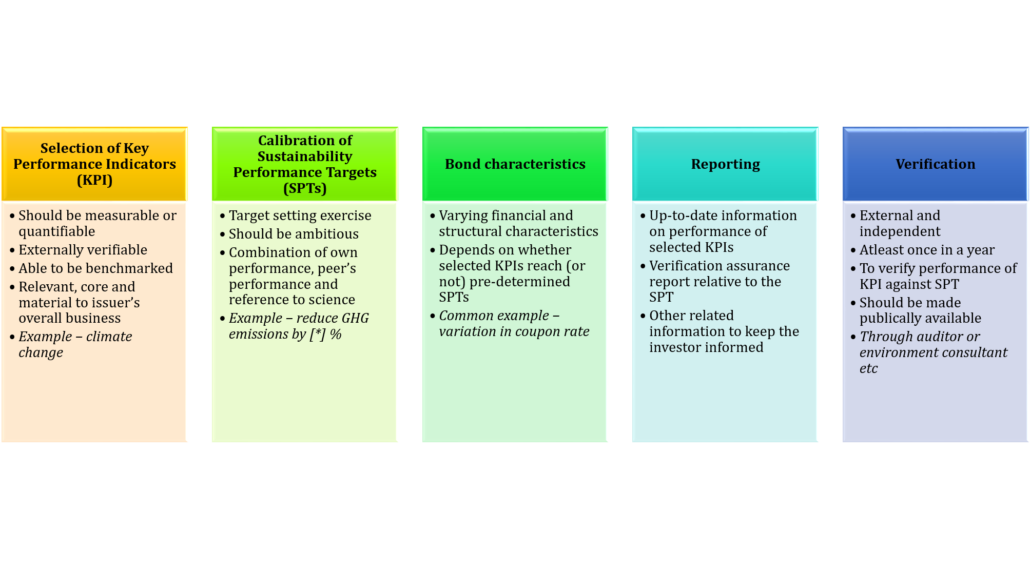 The SLBs require companies to frame key performance indicators and Sustainability Performance Targets. To give an example, a company may frame its sustainability performance target to reduce its greenhouse gas (GHG) emissions by 20% compared to that of the year 2018 as baseline. In this case, the key performance indicators can be reduction of CO2 emissions, reduction of carbon footprint etc.
The SLBs require companies to frame key performance indicators and Sustainability Performance Targets. To give an example, a company may frame its sustainability performance target to reduce its greenhouse gas (GHG) emissions by 20% compared to that of the year 2018 as baseline. In this case, the key performance indicators can be reduction of CO2 emissions, reduction of carbon footprint etc.
The Environmental Finance – Sustainable Bonds Insight, 2021 provides 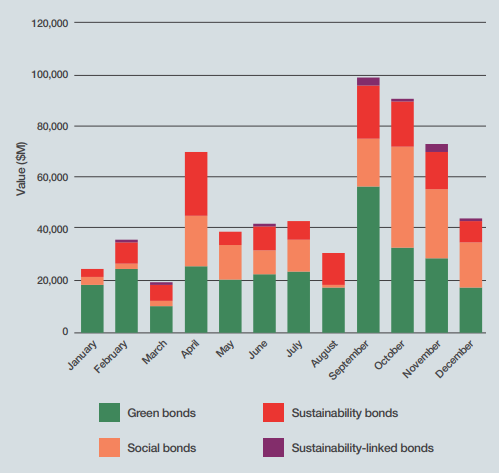 data analytics in respect of the various types of sustainable bonds issued during the year 2020. The data shows high volume of green and social bonds issued during the year as compared to sustainable bonds and SLBs, which are relatively new and evolving concept. While the figures show a comparative between different types of ESG bonds issuance, it also provides an insight on the increasing volume of the ESG bonds being issued in the Covid era (an increase in the bonds issuance in the months of September, October and November).
data analytics in respect of the various types of sustainable bonds issued during the year 2020. The data shows high volume of green and social bonds issued during the year as compared to sustainable bonds and SLBs, which are relatively new and evolving concept. While the figures show a comparative between different types of ESG bonds issuance, it also provides an insight on the increasing volume of the ESG bonds being issued in the Covid era (an increase in the bonds issuance in the months of September, October and November).
The Report shows a comparison of the development of sustainable bond market in the recent years and an estimate of what is expected in the current year 2021. It demonstrates clearly that the sustainable bond market is expected to rise further in the upcoming areas.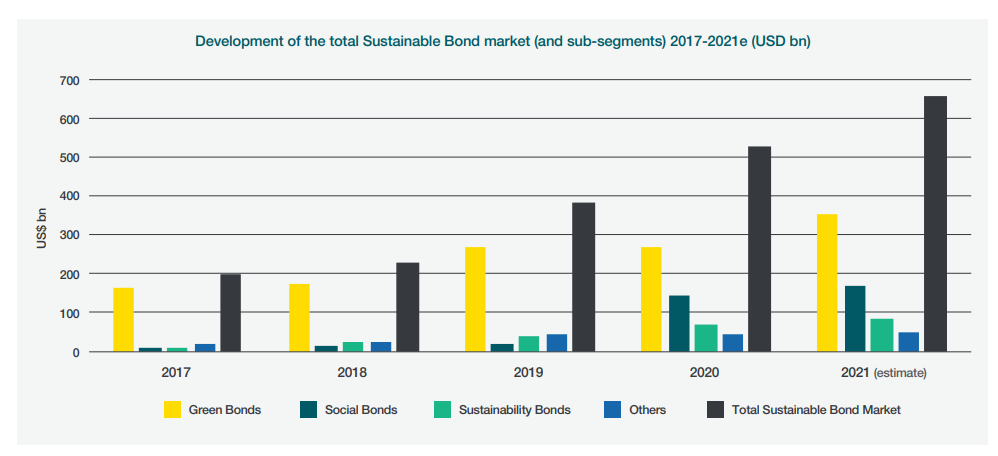
In India, the ESG bonds issuance is witnessing an evident upshot. However, the same has not found much investors’ interest in the country. Nevertheless, the Indian issuer companies have still been able to raise much funds from the issuance of ESG bonds from global investors. The below chart clearly demonstrates the increase in funds raised by way of issue of ESG bonds[4].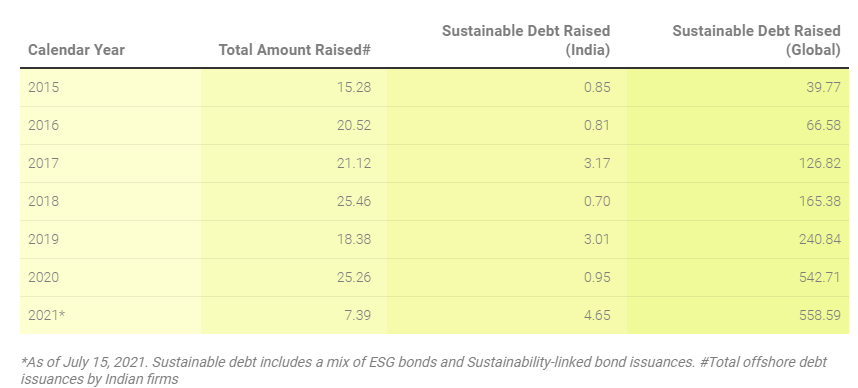 Some of the big Indian issuers of ESG focussed bonds include GreenCo, JSW Hydro Energy, Shriram Transport Finance Company, India Green Power Holdings, ReNew Power, Ultratech Cement Ltd etc. Sustainability linked bonds or SLBs, as discussed, is relatively new and innovative concept in the podium of ESG bonds in the world. India has made a remarkable entry in this field with Ultratech Cement Limited[5], issuing SLBs, thereby, being the first company in India and second in Asia to issue SLBs. The company has raised a total of 400 million USD equivalent to Rs. 2900 crores by way of issuance of such SLBs. The same has been listed in the Singapore Exchange Securities Trading Limited[6].
Some of the big Indian issuers of ESG focussed bonds include GreenCo, JSW Hydro Energy, Shriram Transport Finance Company, India Green Power Holdings, ReNew Power, Ultratech Cement Ltd etc. Sustainability linked bonds or SLBs, as discussed, is relatively new and innovative concept in the podium of ESG bonds in the world. India has made a remarkable entry in this field with Ultratech Cement Limited[5], issuing SLBs, thereby, being the first company in India and second in Asia to issue SLBs. The company has raised a total of 400 million USD equivalent to Rs. 2900 crores by way of issuance of such SLBs. The same has been listed in the Singapore Exchange Securities Trading Limited[6].
Some additional advantages motivation lies for issuance of SLBs –
It is said that behind the investors’ growing interest in ESG bonds lies two reasons – (i) values-driven and (ii) value-driven. While the investors, as part of their responsibility towards the society and environment, consider ESG in their investment analysis, that is not the only reason investors are investing in ESG bonds. Another reason that drives the investors in supporting ESG concerns and investing in ESG bonds is the long term perspective and the expectation of deriving great value from their investment portfolio. The investors believe that a company that invests in the ESG concerns and addresses the ESG issues properly, are more likely to earn profits in the long term. Therefore, while the investors are demonstrating their values and responsible behaviour by choosing ESG focussed bonds, they are also booking adequate profits for themselves in the long run. Now, with the new SLBs coming into picture, the investors are likely to get more benefits out of their investment in the ESG bonds in the form of SLBs. The terms of SLBs are designed as such that the investors get a “step-up” or hike in the coupon rates as and when the issuer misses a pre-defined target (identified as SPTs).
The concept of SLBs comes with a very interesting feature – where investor benefits on the issuer missing its ESG target. Since the investor is making profits on the cost of compromise in ESG responsibilities by issuer, therefore it is controversial that how can an investor show his ESG responsibility at a time when it is making profits on failure to reach ESG targets? However, that is not the case. Another viewpoint towards the case maybe that the investors are motivating their issuers in reaching their ESG targets, and where they fail to do, the investors cast a penalty on the issuer. Whatever the case may be, in both the scenarios, investors are the one who are at the winning side. A recent interesting case of issue of ESG bonds in the form of SLBs may be discussed here. A Japanese firm, Nomura Research Institute Ltd, has issued ESG bonds with the “variable bond characteristics” as below –
In both the cases, the investors will be benefitted. In the first case, the investor will earn return on their investments early, so they will be in possession of their funds again at a shorter span of time. On the contrary, in the second case, though the funds of the investors will be locked for a longer time, the same will bring them higher yield. So, the investors, are very well in a win-win position in all probable cases.
The Ministry of Finance has notified the IFSCA (Issuance and Listing of Securities) Regulations, 2021 or the IFSC Regulations. It is a unified framework for various kinds of securities and is framed with the main intent of consolidating the regulatory requirements in order to access the global capital with more ease and less complexity. The concept of ESG bonds have been specifically recognized and captured under Chapter X of the said Regulations. However, it has to be noted that these IFSC regulations are applicable only for the IFSC-listed companies. No specific framework is provided for ESG bonds for other domestic companies in India outside the scope of IFSC Regulations. The same can still be taken as a guidance for other domestic issuances. While the requirements for issuance and listing of ESG bonds are given in Chapter X, the same is in addition to those under Chapter IX of the Regulations. Please note that, Chapter IX lays down the requirements for issuance and listing of debt securities. By “debt securities” is meant the non-convertible debt securities, as is clear from the definition of “debt securities” under Regulation 2(e) of the Regulations. The additional requirements for the ESG bonds are as follows –
As also envisaged by the Sustainability-linked bond principles of ICMA, disclosure is a main pillar of ESG investing. The IFSCA Regulations also focusses on the disclosure requirements. Under the IFSCA Regulations, the following disclosures are required to be made –
Further, in case of SLBs, the reporting guidance as under the ICMA Guidelines shall apply.
The IFSC Regulations are not applicable to companies other than those listed under the jurisdiction of IFSC Authority. However, the IFSC Regulations are in alignment with other internationally-recognised principles in this regard. We have taken examples of some Indian companies like JSW Steel, Ultratech Cement, Adani Energy, Shriram Transport Finance Co. Ltd, Ultratech Cement etc which provides disclosures and follow the requirements of external review in line with the ICMA Guidelines and IFSC Regulations, which re-iterate requirements of ICMA and other internationally recognised guidelines.
As the world has approached the twentieth century, a shift has become apparent towards more grounded aspects of life – rather than just profit earning. Earlier, it was believed that the corporate world has only one motive – the profit earning motive. However, the focus has now been modified to include various other aspects as well. With instruments like ESG bonds, the efforts are being made to include sustainability in the economy, so that both can progress side-by-side. As the statistics above suggest, India is nowhere lagging behind in the ESG investing. This may be seen as one of the probable cause that IFSCA has included ESG bonds as a specified security in its Listing Regulations. The IFSCA Regulations do not introduce the ESG bonds in India for the first time, rather it just seeks to regulate issuance of the same by means of express regulations in this regard.
Our resource center on Business Responsibility and Sustainable Reporting can be accessed here –
[1] Our article on the same can be read here [2] Read our articles on the same here [3] Green Bond Principles Social Bond Principles Sustainability Bond Guidelines Sustainability-linked Bond Principles [4] https://www.refinitiv.com/ [5] See Page 4 of the Annual Report here [6] Listing confirmation can be accessed here [7] Asian Development Outlook – 2021 [8] Read this here Our other related resources –
